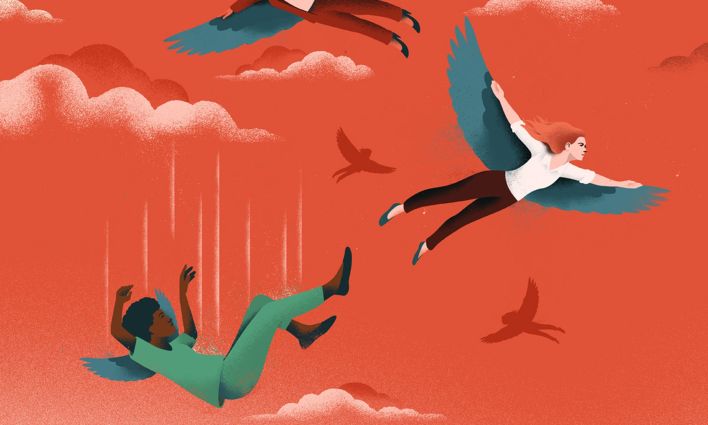Women are taught from a young age that it is “stranger danger” to be feared. But home is the most dangerous place for women: Violence at the hands of a spouse or intimate partner, violence at the hands of a family member.
It’s this violence, Myrna Dawson of the Canadian Femicide Observatory writes, that women “cannot usually avoid by adjusting their daily routines or activities. Women and girls must go home sometime—if they have a home—otherwise their risk of public violence may increase. It is often ‘better the devil you know then the devil you don’t.’ ”
Home is the most dangerous place
The rise in gender-based violence (GBV) that has accompanied the pandemic came as no surprise. Public health orders to shelter in place have fuelled greater tension and strain in many families. At the same time, they increase the isolation of women with violent partners, separating them from the people who can best help them. We’ve seen this in other places and in other emergencies, and we are seeing it now in Canada during COVID-19.
Since the spring 2020, calls and requests for assistance have risen steeply. GBV staff and volunteers across the sector have documented an increase in both the number and severity of reports of violence, as well as the rising incidence of depression, anxiety and self-harm among victims trapped in abusive situations, including Indigenous women, those with precarious immigration status and women with disabilities.
More than 16 months into the pandemic, new data from Statistics Canada tell the story: The first three months of 2020 saw an increase in the number of police-reported crimes compared to the same period in 2019. When country-wide public health restrictions were introduced in April 2020, reports of criminal activity dropped off, falling below 2019 levels for the rest of the year—for both men and women.
What the decline in violent crime hides, though, is the increase in police-reported intimate partner violence (IPV) of all kinds, including sexual assault, committed by current and former spouses or partners and current or former intimate partners.
Figures from the Canadian Femicide Observatory for Justice and Accountability provide additional evidence of the pandemic’s violent toll on women. Last year, 160 women and girls lost their lives across the country, an increase from 146 in 2019. The first six months of 2021 saw a rate even higher than in 2020: 92 women were killed through this time.
These estimates represent just the tip of the iceberg. Only 19% of spousal violence cases are reported to the police by the victim or someone else and only 6% of sexual assault cases are reported. The pandemic took a precarious situation and made it worse.
Marginalized women face the highest risk of violence
In 2018, almost half of women (44%) who had ever been in an intimate partner relationship —approximately 6.2 million women aged 15 and older—reported experiencing psychological, physical, or sexual violence at some point in their lives.
The risk of violence is especially high among Indigenous women, women with disabilities and "sexual minority women" (women who are not heterosexual). The same 2018 study found Indigenous women were much more likely to experience all forms of intimate partner violence over their lifetimes compared to non-Indigenous women.
In total, almost two-thirds (63%) of Indigenous women reported being physically or sexually assaulted at the hands of an intimate partner or another assailant. Sexual minority women reported experiencing equally high levels of violence, notably among bisexual women.
Among women with disabilities who had been involved in an intimate partnership, 55% reported experiencing some form of IPV, 18 percentage points higher than women without disabilities. And over half of all women with disabilities (57%) reported being physically or sexually assaulted at least once.
Indeed, new research has found the higher rate of violent victimization among women with disabilities—and more specifically their higher rate of sexual assault—accounts for entire difference in the rate of victimization between women and men.
Long past time for action
Myrna Dawson makes the point that “private violence … is facilitated and maintained by public violence in the form of the ongoing threats and everyday experiences of misogyny, abuse and violence perpetrated against women and girls by men … public violence serves to remind women to stay in their place.” Yet women’s homes are not safe for too many.
In recent years, the federal government has made targeted investments in community services, support for survivors and their families, related legal reforms, and research. This past year, the government allocated $100 million to shelters serving women and children fleeing violence, sexual assault centres, and other programs to provide assistance to purchase supplies and reorient services. Over $700 million has been directed to creating a continuum of culturally relevant supports for Indigenous women, children and 2SLGBTQQIA+ people facing gender-based violence.
These investments provided crucial support but fell considerably short of the comprehensive, cross-jurisdictional, and intersectional plan needed to permanently reverse rising violence and ensure that women can live free from violence, wherever they live.
All eyes are now focused on federal and provincial/territorial governments that struck an agreement “to develop” a National Action Plan to End Gender-Based Violence last January. Over $600 million was promised in Budget 2021 to support anti-violence programming over five years, and $2.2 billion to “accelerate” work on a National Action Plan in response to the 2019 Final Report of the National Inquiry into Missing and Murdered Indigenous Women and Girls’ Calls for Justice.
A Federal Pathway, released on June 3, presents high-level commitments by federal and provincial/ territorial governments but fails to present explicit priorities with goals and implementation timelines clearly associated with each of the 231 Calls for Justice.
It’s long past time to move forward with a comprehensive, appropriately resourced 10-year National Action Plan to prevent and combat all forms of violence against women—as recommended by a leading coalition of gender equality organizations.
Such a plan should include: clear goals and targets for reducing violence; a secretariat or office for developing, implementing, and evaluating the National Action Plan; an independent mechanism for monitoring and publicly reporting on progress/lessons learned; and escalating investments in prevention and wraparound support for survivors as well as strategies for reforming our legal and justice systems.
These pillars should be harmonized with an implementation plan to prevent and combat all forms of violence against First Nations, Inuit, and Métis women, girls, and Two-Spirit Peoples. Indigenous women’s organizations have already set out their recommendations and guidance.
It is long past time for action.
Plans for implementing the MMIWG Calls for Justice:







